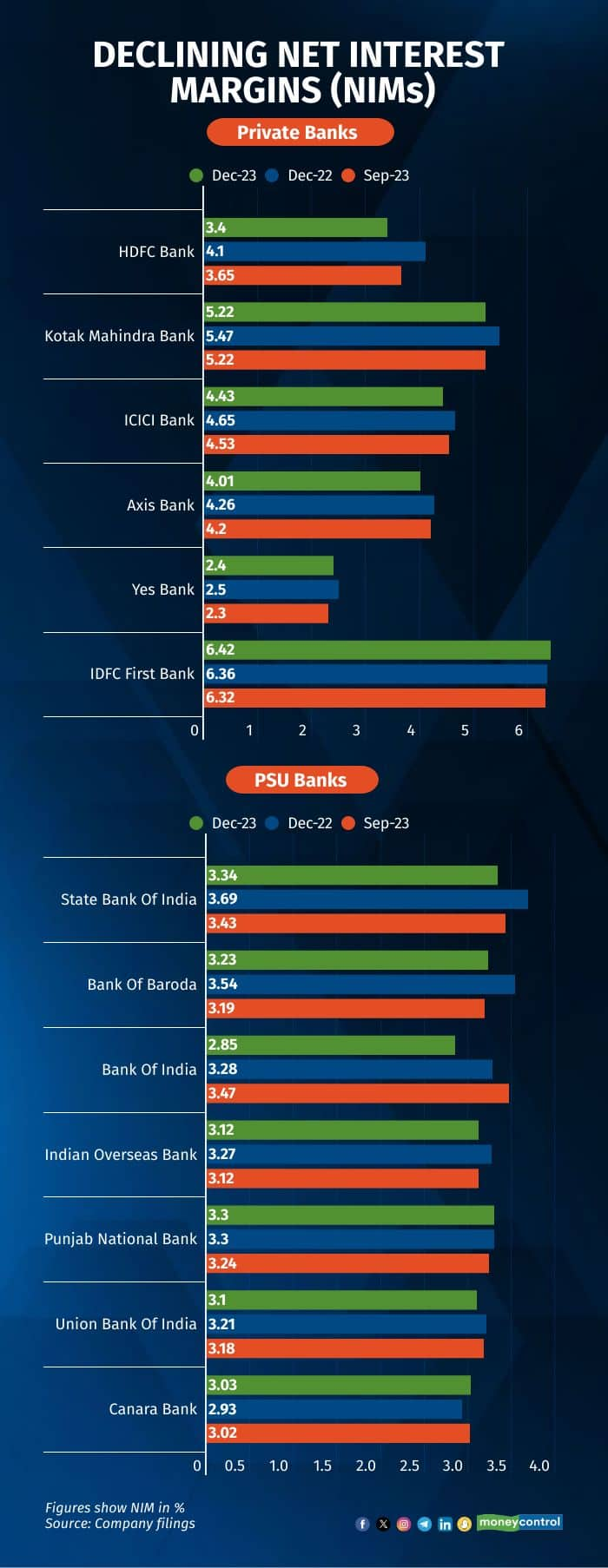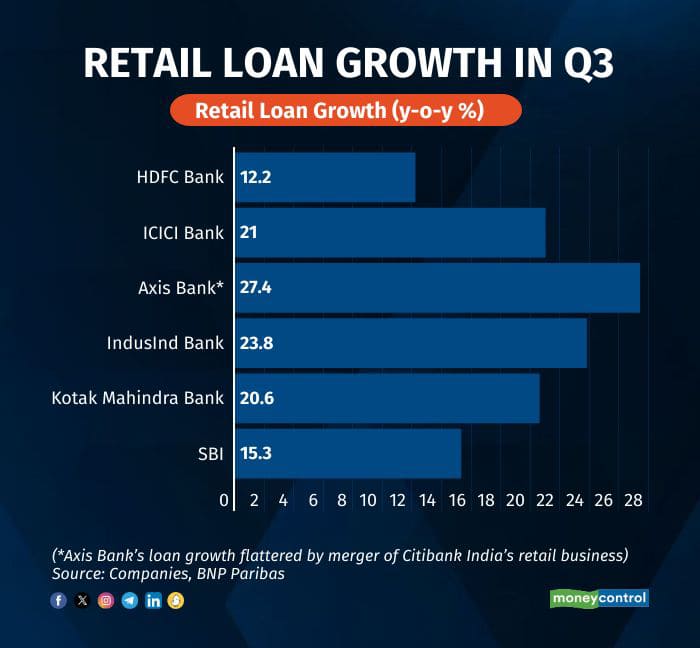



Robust loan demand, a spurt in non-interest income and healthy asset quality boosted the third-quarter results for Indian banks but persisting pressure on the margins front may mar their near-term outlook.
While private banks’ domestic loan growth was faster than their public-sector peers, it was the PSU lenders which drove the asset quality improvement with declining slippage ratio.
However, the public sector banks were bedevilled by a characteristically PSU problem – ballooning wage and pension costs.
Also Read: SBI Q3 results miss estimates on one-time loss. But there is a twist in the tale
That said, the outlook for bank credit offtake continues to remain positive for FY24, supported by factors such as robust GDP growth, an upswing in the capex cycle and firm loan demand in the retail segment.
Margin Matters
A common thread running through banks’ Q3 numbers was the pressure on net interest margin (NIM) – which is a measure of the amount of money that a lender earns in interest on loans compared to the amount it pays in interest on deposits.
With system liquidity tightening and the Reserve Bank of India (RBI) yet to commence its rate cutting cycle, banks are forced to offer higher interest rates to attract depositors, thus putting pressure on NIMs.

The disappointment in margins in Q3 was also due to lower-than-expected growth in CASA (current accounts, savings accounts), which are a cheap source of funds for banks.
“The incremental pressure point on margins (till rates remain high) are repricing of Term Deposit (TD) stock and higher TD proportion in NDTL (Net Demand and Time Liabilities). We expect the first factor to get phased out by 1QFY25 as TD rates have peaked and the bulk of the repricing is behind,” analysts at BNP Paribas said.
Net Demand and Time Liabilities (NDTL) is the amount of money available to a bank for providing loans, as this is the sum of all the deposits made to the bank less the amount it has invested in other banks.
Q3 earnings review: Energy, infra firms lead profit surge; IT, FMCG face headwinds
In their post-earning concalls, most bank managements exuded confidence that margin compression has bottomed out.
“…we have said in the past that we expect the full-year margin of this year to be at a similar level as of last year, and that implies some further margin compression in Q4, but it should be much lower than what we have seen,” Anindya Banerjee, Group Chief Financial Officer at ICICI Bank, told analysts in the bank’s concall.
However, a turnaround is expected only when the RBI relents on rates.
“…I think the retail deposit rates have remained stable for a fair period of time now, at least the peak rate… Of course, in Q3, given the overall liquidity environment, we did see some amount of hardening of the wholesale deposit rates, which is reflected in the certificate of deposit rates and also the rates being quoted for high value kind of deposits,” he added.
“If you look at current systemic liquidity, it is running at a negative. So, I guess that scenario will stay for some time until, maybe, the monetary policy starts to turn a little more accommodative,” Banerjee said.
Growth Drivers
Indian bank credit is growing at 16 percent, faster than the GDP growth of 9 percent, implying a credit multiplier of 1.7x, foreign brokerage firm Jefferies said in a recent note.
“This is being aided by stronger growth in consumer loans, a ramp up of segments like SME, inflation led growth in working capital credit and some uptick in capex activity," it added.
The regulators too have highlighted the retail led growth in bank credit.
In its latest Financial Stability Report in December 2023, the RBI said bank credit has undergone compositional shifts in recent times, with an increasing proportion of credit going to services and the retail sector.
“Over the past two years, banks and NBFCs have seen rapid and persistent growth in retail loans, especially unsecured lending. Between September 2021 and September 2023, banks’ retail loans grew at a compound annual growth rate of 25.5 percent, which exceeded the headline credit growth of 18.6 percent,” the RBI said.
Consequently, the share of retail lending in gross advances increased from 37.7 percent in September 2021 to 42.2 percent in September 2023. Alongside, unsecured retail lending grew 27.0 percent during the same period, taking its share in total retail lending to 23.3 percent (9.83 percent of total gross advances of the banks).

However, deposit growth lagging credit offtake may present a fresh challenge.
“We believe the primary issue for banks is that system loan growth (at 16 percent YoY) continues to significantly outpace deposit growth (12 percent YoY as of January 12, 2024), which is not sustainable, given the loan-to-deposit ratio (LDR) across the system is at a 10-year high,” analysts at Nomura pointed out.
Moreover, system deposits over long periods of time largely track nominal GDP growth and it is difficult to argue for any significant pick-up in deposit growth for the system to bring down LDRs.
“Hence, while systemic tight liquidity may be transient, the challenge for loan growth from deposit mobilisation could still persist over the medium term. We expect system loan growth to moderate to 14 percent/13 percent by FY24/25F,” they added.
Disclaimer: The views and investment tips expressed by experts on Moneycontrol.com are their own and not those of the website or its management. Moneycontrol.com advises users to check with certified experts before taking any investment decisions.
Discover the latest Business News, Sensex, and Nifty updates. Obtain Personal Finance insights, tax queries, and expert opinions on Moneycontrol or download the Moneycontrol App to stay updated!